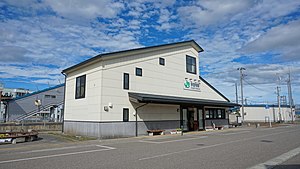Jingūji Station
Jingūji Station 神宮寺駅 | |||||||||||
|---|---|---|---|---|---|---|---|---|---|---|---|
 Jingūji Station in June 2019 | |||||||||||
| General information | |||||||||||
| Location | Hongōno-21 Jingūji, Daisen-shi, Akita-ken 019-1701 Japan | ||||||||||
| Coordinates | 39°29′41.8″N 140°25′34.7″E / 39.494944°N 140.426306°E | ||||||||||
| Operated by | |||||||||||
| Line(s) | ■ Ōu Main Line | ||||||||||
| Distance | 253.0 kilometers from Fukushima | ||||||||||
| Platforms | 1 island platform | ||||||||||
| Other information | |||||||||||
| Status | Staffed | ||||||||||
| Website | Official website | ||||||||||
| History | |||||||||||
| Opened | August 21, 1904 | ||||||||||
| Passengers | |||||||||||
| FY2018 | 202 daily | ||||||||||
| Services | |||||||||||
| |||||||||||
| |||||||||||

Jingūji Station (神宮寺駅, Jingūji-eki) is a JR East railway station located in the city of Daisen, Akita Prefecture, Japan.
Lines
Jingūji Station is served by the Ōu Main Line, and is located 253.0 km from the terminus of the line at Fukushima Station.
Station layout
Jingūji Station consists of a single ground-level island platform, with the tracks a Platform 1 dual gauge for use by through traffic of the Akita Shinkansen. The platform is connected to the station building by a footbridge. The station is staffed.
Platforms
| 1 | ■ Ōu Main Line | for Akita |
| 2 | ■ Ōu Main Line | for Yokote and Ōmagari |
History
Jingūji Station was opened on August 21, 1904 on the Japanese Government Railways (JGR), serving the town of Kamioka, Akita. The JGR became the Japan National Railways (JNR) after World War II. The station was absorbed into the JR East network upon the privatization of the JNR on April 1, 1987. A new station building was completed in July 2008.
Passenger statistics
In fiscal 2018, the station was used by an average of 202 passengers daily (boarding passengers only).[1]
Surrounding area
- former Kamioka Town Hall
- Jingūji post office
 National Route 13
National Route 13
References
- ^ 各駅の乗車人員 (2018年度) [Station passenger figures (Fiscal 2018)] (in Japanese). Japan: East Japan Railway Company. 2019. Retrieved 21 December 2019.
External links
- JR East Station information (in Japanese)


